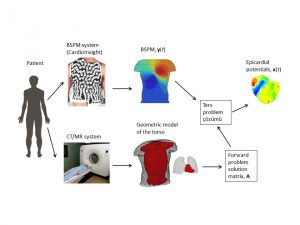Projects
Electrocardiographic Imaging

Cardiovascular diseases, including heart disease and stroke, are the leading cause of death worldwide. Researchers have been extensively working on methods for early diagnosis and treatment of these diseases, with the goal of decreasing these death tolls. One of the cutting-edge research topics on heart diseases is noninvasive electrocardiographic imaging (ECGI), in which the electrical activity of the heart is estimated from electrocardiographic measurements obtained from the body surface, using densely distributed electrodes, and a mathematical model of the body. From a mathematical point of view, this estimation problem is called the “inverse problem of electrocardiography (ECG).” Since this technique provides high-resolution images of the electrical activity directly on the heart surface without actually placing electrodes on the heart, it is a much superior alternative to classical ECG, the most widely used technique in clinics to obtain information on heart pathologies. In the classical ECG, only a limited number of electrodes can be placed on the body surface, and the electrical activity is obtained indirectly, which causes a loss of information.
ECGI has great potential for clinical applications; patient-specific potential maps can be used by physicians to determine regions of abnormal atrial or ventricular activation before ablation procedures for pre-procedure planning; they can provide in-depth information on pathologies of the heart such as regions with ischemic or infarcted tissue; they can be used to reveal conduction anomalies such as bundle branch blocks, Wolf Parkinson White (WPW) syndrome, and other types of arrhythmias, all of which would give information about susceptibility of the patient to a possible life-threatening arrhythmia.
ECGI is a research topic that is best handled using a multidisciplinary approach. Researchers and/or clinicians with backgrounds in topics such as cardiology, electrophysiology of the heart, bioelectric phenomena in the torso volume conductor, modeling of the heart’s electrical activity, signal acquisition and processing, medical image segmentation, and model generation, etc., team up to tackle larger problems with significant clinical implications. This growing interest in clinical applications of ECGI and multidisciplinary collaboration inspired the leading researchers in the community to found the Consortium of Electrocardiographic Imaging. The main goal of this consortium is to bring together researchers working on ECGI, with activities such as organizing and attending conferences, organizing challenges (hackathons) for jointly working on open questions in ECGI, sharing data, and collaborating on publications in high-impact journals.
Our research on ECGI mainly focuses on solving the inverse ECG problem using statistical estimation techniques. These techniques are advantageous over traditional methods due to their flexibility in incorporating the spatial and temporal information of heart potentials in solving the inverse ECG problem and yielding confidence intervals that help assess the accuracy of the solutions. Over the years, we have conducted research projects funded by the Scientific and Technological Research Council of Turkey, and university (METU) funded projects on ECGI. MS and Ph.D. students have been working in our laboratory on various topics related to ECGI, including mathematical model generation relating the heart potentials to body surface potentials starting from medical images (i.e., solving the forward ECG problem); modeling the electrical activity of the heart under normal and pathologic conditions; mainly and most importantly on solving the inverse ECG problem. We published several papers in international journals and presented our work at national and international conferences.
International Collaborations
- Principal Investigator, Scientific and Technological Research Council of Turkey (TUBITAK) – jointly supported by the French Ministry of Foreign Affairs; Grant No: 221N175; “INVERSE: Non-Invasive Detection of Ventricular Arrhythmogenic Substrates,” 6/2022 – 6/2024.
- Principal Investigator, Scientific and Technological Research Council of Turkey (TUBITAK) – jointly supported by Slovak Academy of Sciences (SAS); Grant No: 120N200; “ClinECGI: Performance Evaluation of Noninvasive Electrocardiographic Imaging for the Localization of Premature Ventricular Contractions from Clinical Data,” 5/2021 – 5/2024.
- MC Member – COST, CA19137 – Sudden cardiac arrest prediction and resuscitation network: Improving the quality of care, 26/10/2020-25/10/2024.
National Projects
- Principal Investigator, Scientific and Technological Research Council of Turkey (TUBITAK); Grant No: 118E244; “Application of Bayesian Estimation Methods to Electrocardiographic Imaging: Prior Model Selection and Reduction of Noise Effects,” 10/2018 – 10/2021.
- Principal Investigator, Scientific and Technological Research Council of Turkey (TUBITAK); Grant No: 111E258; “Non-invasive Imaging of Electrical Activity of the Heart in terms of 3 Dimensional Transmembrane Potential Distributions,” 4/2012 – 4/2015.
- Principal Investigator, Scientific and Technological Research Council of Turkey (TUBITAK); Grant No: 105E070; “Inverse Electrocardiography: Statistical Estimation of Bioelectrical Sources of the Heart,” 1/2007 – 1/2010.
- Principal Investigator, METU BAP-2008-R-08-11-15 “Database Generation for Snoring Sound Analysis,” 6/2008 – 5/2009.
- Principal Investigator, METU BAP-2005-03-01-03 “Numerical Modeling of the Electrical Activity of the Heart,” 1/2005 – 12/2006.
- Principal Investigator, METU BAP-2004-03-01-01 “Solution of Forward and Inverse Electrocardiography Problems using Realistic Heart and Torso Models,” 1/2004 – 12/2004.
